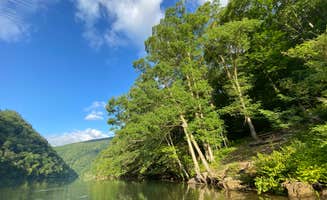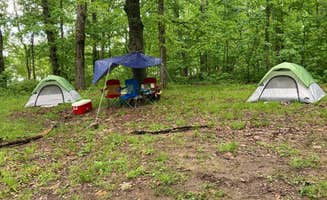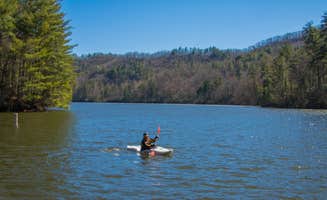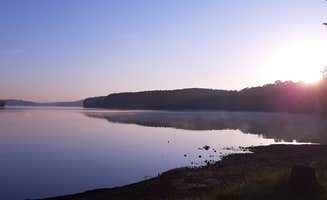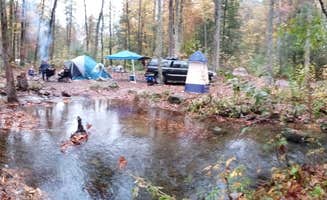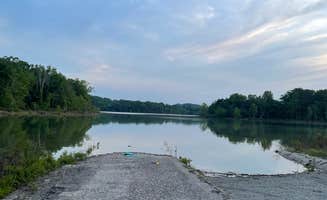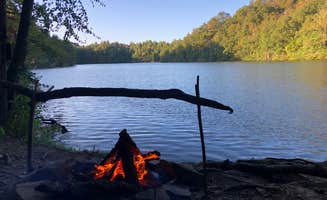Dispersed camping near Farragut, Tennessee offers access through a network of forest service roads that can become challenging after rainfall. Most primitive sites in the region sit between 800-1,500 feet elevation, with mountain locations experiencing temperature drops of 10-15 degrees compared to Farragut proper. The camping season typically runs March through November, though lower elevation sites remain accessible year-round with proper cold-weather gear.
What to do
Kayaking at Calderwood Lake: Access primitive campsites by water at Calderwood Lake Primitive campground, where non-motorized boats provide the best experience. "If you are willing to bring everything with you, pack everything out, and paddle multiple miles on a nonmotorized finger lake, this is the place for you!" notes camper Tyler J. The lake's clear waters create ideal conditions for paddling and fishing.
Hiking to waterfalls: Explore trails near Harold Parrish Lower Camp where short hikes lead to swimming holes and cascades. "Wolfcat falls is really pretty with a huge swimming hole. Lots of fun and not far at all from the Lower camp sites," reports Claire K. Accessing these sites requires either a challenging 13.5-mile hike or a combined boat-and-hike approach of about 1.5 miles.
Fishing from shoreline: Sourwood Campground provides direct river access for anglers. "The closeness to the river is the main attraction here. It's ever-present sounds make it easy to forget everything," explains camper Dan R. The nearby TWRA fish hatchery supplies local waters, making for consistent catches through spring and summer.
What campers like
Privacy between sites: Lake Santeetlah Dispersed sites feature well-spaced camping areas that prevent overcrowding. "I was hoping to car camp a little closer to NOC but not in a campground but this is the closest I could find in February. Very quiet and clean and the sites are very well laid out and maintained!" reports Natalie R.
Wildlife viewing: Bi-Color Campground in Catoosa WMA offers excellent wildlife observation opportunities. "This area is beautiful almost all times of the year! Plenty of wildlife and lots of shady areas," notes John B. Another camper mentioned that "My dog and I stayed for 2 nights and 2 days. Lots of wildlife sounds at night. Also a random heard of cattle strols through every now and again."
Lake swimming: Many dispersed sites provide direct water access for cooling off. At Long Hungry Road Dispersed Campsites, "Sites are mainly flat for tent camping. The dogs loved it because our site was right on the lake," says Amanda R. Most waterfront sites have gradual entries suitable for wading.
What you should know
Road conditions vary dramatically: Access to many sites requires careful driving on unpaved roads. At Bi-Color Campground, one camper warned, "Dirt rd, washboard out was north to Rock Creek campground steep downhill grade narrow. My opinion not for 5th wheel." Check recent weather reports as many access roads become rutted after heavy rain.
Campsite reservation limitations: Most sites operate first-come basis with weekend competition. "We showed up around 2:30-3 o'clock on a Sunday afternoon and most of the spots were already called for. Seems you gotta get there early if you want easy water access," reports Jake H. about Long Hungry Road sites.
Variable cell service: Communication capabilities change dramatically between locations. At Lake Santeetlah, "AT&T works just fine!" while at Bi-Color Campground, "No cell for miles," according to Michael W. Download offline maps before heading to remote areas.
Tips for camping with families
Select established sites: For easier family camping, choose locations with basic amenities. "Jackson Island Dispersed Campground is very easily accessible and has no facilities other than garbage bins," notes Andrew R. The concrete pads at many sites provide stable, level surfaces for setting up family-sized tents.
Consider noise factors: Frog choruses and road noise affect different campgrounds differently. At Lake Santeetlah, one camper mentioned, "Fairly quiet besides the rice burners heading to Tail of the Dragon." Wildlife sounds typically peak at dawn and dusk.
Security presence: Rangers patrol certain areas regularly, providing additional safety. At Lake Santeetlah Dispersed, Natalie R. noted, "Highway Patrol and Park Rangers patrol pretty frequently so I felt really safe as a solo female."
Tips from RVers
Size restrictions matter: Most dispersed sites accommodate smaller rigs only. At Sourwood Campground, Victor S. advises, "It would absolutely NOT be a good location for a class A motorhome but maybe some of the smaller class C's could get settled in there. I saw a small camper trailer sitting comfortable. I would not like to try to get a larger camper or 5th wheel in there, way too tight to turn around."
Ground conditions: Evaluate site firmness before committing. "All of the sites had solid packed ground so it would not be hard to level whatever rig you use," notes a camper at Sourwood. However, spring conditions often soften sites, making leveling more challenging.
Water access considerations: RV campers should note where to access water for refills. Nicholas from Bi-Color Campground warns, "There was no accessible water near by so make sure you bring your own provisions." Most campers recommend bringing at least one gallon per person per day.


